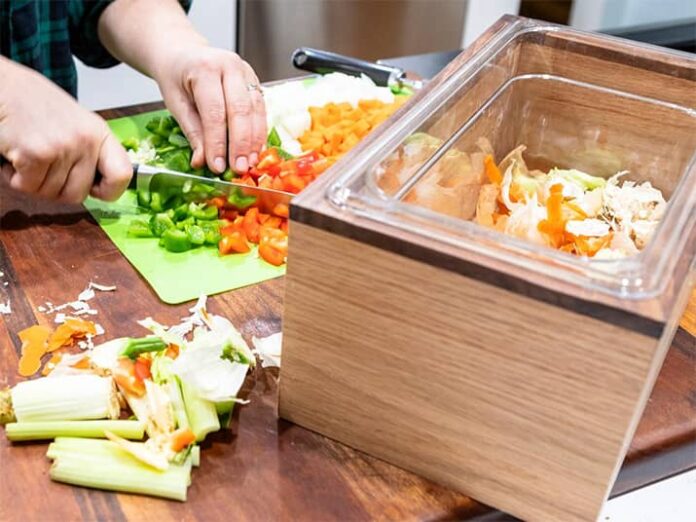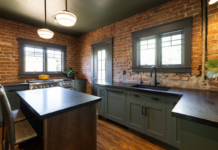[ad_1]
Composting is a simple and easy way to get started for those looking to reduce their carbon footprint or live a greener lifestyle. Composting is a process of breaking down organic waste, such as food scraps, leaves, and grass clippings, into a nutrient-rich soil amendment that can be used to fertilize plants and gardens. Although composting may seem rather complex, creating a DIY kitchen compost bin is an easy and affordable way to reduce your carbon footprint and create nutrient-rich soil for your plants.
Not sure where to get started? We compiled the perfect do-it-yourself guide for creating an easy and green kitchen compost bin. Whether you’re looking for a DIY countertop or an under-sink compost bin, follow along to learn how to make a kitchen compost bin and seamlessly incorporate it into your natural kitchen design.

How to Make Your Own Indoor Compost Bin
Even if you aren’t the handiest individual with a set of tools, there’s no need to fret. Creating a DIY kitchen compost bin doesn’t have to be hard. Here are the steps to create a simple kitchen compost bin:
Materials Needed:
- A plastic or metal container with a tight-fitting lid
- Drill with a large drill bit (1/2-inch or larger)
- Newspaper or brown paper
- Compost starter (optional)
Step 1: Choose a Container

The first step is to find a container that is at least 1 cubic foot in size and has a tight-fitting lid to prevent odors and pests from escaping into the rest of your kitchen. For the low-budget route, we recommend a plastic container with a lid, but if you have a bit more room in your budget you may opt for a metal container that is more durable and attractive in your kitchen.
Step 2: Drill holes

Once you’ve secured your container, use your drill with a large drill bit to make holes in the bottom and sides of the container. Make sure the holes are big enough to allow air to circulate and for excess water to drain out. The placement of the holes needs to be optimal and we recommend spacing them out about 1-2 inches apart on all sides of the container.
Step 3: Add a Layer of Paper

Add a layer of newspaper or brown paper to the bottom of the container. You may even opt for dried leaves or grass clippings! This will help absorb any excess moisture and prevent the compost from sticking to the container.
Step 4: Add a Compost Starter (Optional)

Although optional, if you’re new to the world of composting you may want to work with a compost starter (at least in the beginning!). If you use a compost starter, add a small amount to the bottom of the container to help jumpstart the composting process and reduce any odors.
Step 5: Start Composting

As they begin accumulating, begin adding food scraps, yard waste, and other organic materials to the bin. However, you can’t just add them in and leave them be. You need to regularly mix the materials inside the bin to promote decomposition and prevent odors.
Step 6: Maintain the Bin

Keep the compost moist by adding water when necessary, but be careful not to overwater. You may also want to add additional layers of paper or shredded leaves to absorb excess moisture. Stir the contents of the bin regularly to promote decomposition and prevent clumping.
Step 7: Harvest the Compost

After a few months, your compost should be ready to use. Harvest the compost by removing it from the bottom of the bin and using it to fertilize your plants.
With these steps, you can easily create a DIY kitchen compost bin and reduce your carbon footprint while creating nutrient-rich soil for your plants.
Frequently Asked Questions
What are the benefits of composting?
There are many benefits to composting, including:
- Reducing landfill waste: Composting reduces the amount of organic waste that ends up in landfills, where it produces methane, a potent greenhouse gas that contributes to climate change.
- Improving soil health: Compost is a rich source of nutrients and beneficial microorganisms that can improve soil health and fertility, which can lead to healthier and more productive plants for your indoor herb garden or backyard garden.
- Saving money: Composting can save money on fertilizers, which can be expensive to purchase.
- Conserving water: Compost can help the soil retain moisture, which can reduce the need for watering.
- Reducing greenhouse gas emissions: By reducing the amount of organic waste that goes to landfills, composting can help reduce greenhouse gas emissions, which contribute to climate change.
- Encouraging sustainability: Composting is a sustainable practice that encourages the reuse of organic materials and promotes a more circular economy.
How long does it take for compost to be ready?
Composting can take anywhere from a few weeks to several months, depending on various factors, such as the size of the compost pile, the type of materials being composted, and the environmental conditions (i.e. temperature and moisture). Keep an eye on your compost and once it is dark brown, crumbly, and smells earthy, you’ll know it is ready to use.
What can I compost?
One of the best things about composting is that it is extremely versatile and allows you to safely dispose of your waste in an eco-friendly manner. You can compost fruit and vegetable scraps, coffee grounds, tea bags, eggshells, yard waste, and even some types of paper. However, you should never compost meat, dairy, and fatty or oily foods in a kitchen compost bin as they can attract pests and take longer to break down.
How do I know if my compost pile is working?
A healthy compost pile should have a pleasant earthy smell and be moist but not too wet. To check if the compost is ready, you can use a compost thermometer or simply look for signs that the materials have broken down into a dark, crumbly substance.
Can I compost in an apartment or a small space?
You can compost in an apartment or small space using a variety of methods, such as a mini compost bin in your cabinets, an under-sink compost bin, or a small countertop compost bin. These methods are designed to be compact and odor-free, making them ideal for small spaces.
The post Create an Easy & Green DIY Kitchen Compost Bin in 7 Steps appeared first on Kitchen Cabinet Kings Blog.
[ad_2]
kitchencabinetkings.com










